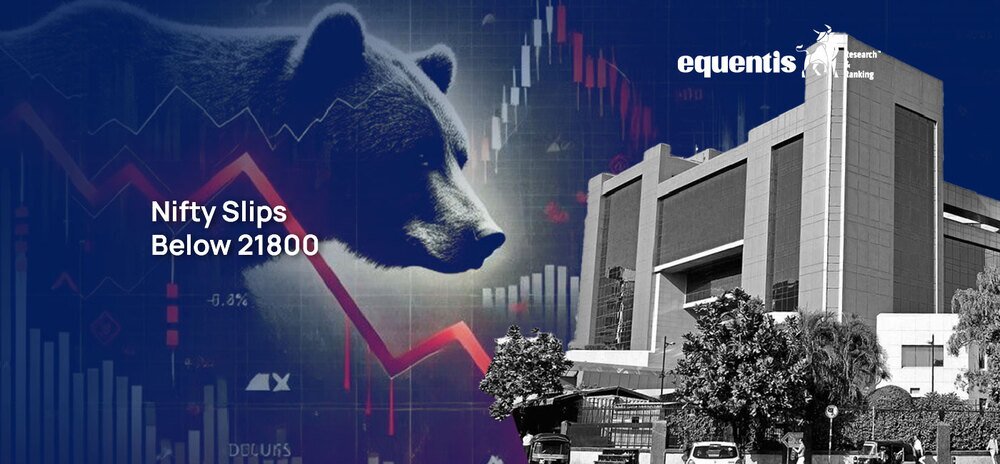You were probably shocked if you opened your trading app this morning expecting business as usual. The Indian stock market opened deep in the red on Monday, April 7, aligning with global market weakness. The Nifty 50 crashed below the 21,800 level, and the Sensex followed closely, plunging by nearly 4,000 points in early trade.
Nervousness swept through Dalal Street within minutes of the opening bell. The broader market took an even bigger hit, and by mid-morning, nearly ₹19 lakh crore had been wiped off investor wealth. So what exactly happened? Let’s examine the five key reasons behind the meltdown and unpack the layers that led to such a sharp fall.
A Snapshot of the Market Chaos
Let’s first take stock of what went down:
- At 7:20 am, the GIFT Nifty quoted 22,130 — down over 900 points or 3.6%.
- Around 9:15 am, the Nifty 50 opened at 21,758.40, down 1,146.05 points from its previous closing of 22,904.45 or 5%.
- The Sensex was down 2,752 points or 3.65%, sitting at 72,613.
- BSE Midcap index dropped over 8% to 37,203.21.
- BSE Smallcap index tanked 10.5%, hitting a low of 41,013.68.
- India’s VIX surged by 54.98%, climbing to 21.32 — reflecting an extremely high level of fear.
- The total market capitalization of BSE-listed companies fell from ₹403 lakh crore to ₹384 lakh crore.
This was one of the sharpest single-day erosions of investor wealth in recent times. Source: MoneyControl
1. Global Selloff Triggered by U.S. Tariff Spree
The most immediate cause of the crash was the ripple effect of global selloffs. Over the weekend, U.S. President Donald Trump reiterated his commitment to reciprocal tariffs, even calling them “medicine” necessary to fix long-standing trade issues. His statement, “I don’t want anything to go down. But sometimes you must take medicine to fix something” — set off alarm bells globally.
Major global indices reflected the damage:
- On Friday, the S&P 500 dropped 5.97%.
- Dow Jones fell 5.50%.
- Nasdaq lost 5.73%.
- On Monday, Asia followed suit — the Taiwan Weighted index fell 10%, and Japan’s Nikkei dropped 7%.
- With global investors fleeing riskier assets, Indian markets were bound to catch the fallout. When global markets bleed, domestic sentiment tends to follow.
2. Tariff Impact Still Not Fully Priced In
Even though markets have been aware of the U.S. administration’s tariff moves, there’s a growing belief that the full impact isn’t yet reflected in equity prices. The Trump administration’s latest move involves sweeping tariffs across 180 countries, creating renewed uncertainty.
Brokerage firm Emkay Global noted that the direct impact on India may be limited, but a broader U.S. recession could reduce FY26 Nifty EPS by around 3%. If earnings expectations are slashed, the valuation rerating could drag the Nifty down further — potentially toward 21,500 levels.
Markets typically price in known risks, but fresh panic sets in when those risks escalate or timelines shift — as we saw today.
Source: Livemint
3. Fears of a Global Growth Slowdown
Trade wars rarely end well for global growth, and that fear is now front and center.
After the U.S. imposed fresh tariffs on April 2, China retaliated with 34% additional tariffs on American goods. This tit-for-tat escalation raised alarm over a global economic slowdown.
According to a Reuters report, JPMorgan raised the probability of a U.S. and global recession from 40% to 60%. Bruce Kasman, head of economics at JPMorgan, warned that if sustained, these trade policies could “tip a still healthy U.S. and global expansion into recession.”
For India, while the direct tariff impact may be smaller, ripple effects can’t be ignored. Global demand softens, exports shrink, corporate profits get squeezed, and GDP forecasts are slashed.
In response to the new tariffs, Goldman Sachs revised India’s growth forecast for FY26 from 6.3% to 6.1%. Citi predicted a 40 basis point hit, and QuantEco Research estimated a 30 basis point impact on the Indian economy. Source: Livemint
4. Foreign Portfolio Investors Resume Selling
April began with a shift in foreign investor behavior. After net buying in March, foreign portfolio investors (FPIs) turned sellers again. By Friday, FPIs had sold ₹13,730 crore worth of Indian equities in the cash segment. This reversal is driven by the uncertainty around the global macro outlook and concerns that India could face the brunt of foreign capital flight if the U.S. recession materializes.
There’s also anxiety around whether India can manage a favorable trade equation with the U.S. If not, that could further spook foreign investors who are already jittery about valuations and growth risks.
5. RBI Policy and Earnings Season Add to Caution
Two major domestic events this week have added to the cautious mood:
- The Reserve Bank of India’s (RBI) Monetary Policy Committee is set to announce its decision on April 9. Markets are unsure whether the RBI will cut rates or introduce other supportive measures to bolster growth.
- Q4 earnings season kicks off with TCS reporting on April 10. Investors are not just focused on the numbers but also on forward-looking commentary — especially from sectors like IT, which have significant exposure to the U.S. economy. Given the broader uncertainty, investors may move into a wait-and-watch mode until clearer cues emerge.
The Broader Market Tells the Story
The damage wasn’t limited to the large caps. Broader indices faced deeper cuts, with BSE Midcap and Smallcap indices crashing over 8% and 10.5%, respectively. The advance-decline ratio was a bleak 1:10 — meaning that ten were falling for every one stock rising. All 13 sectoral indices on the NSE ended in the red.
Among the worst hit were:
- Nifty Metal, due to fears of falling industrial demand.
- Nifty IT, owing to its dependence on U.S. revenues.
- Even defensive sectors like FMCG and pharma, typically safer in volatile times, saw significant losses.
Source: Livemint
Conclusion
Today’s market crash was a reminder of how quickly sentiment can turn when global and domestic factors collide. While some of the concerns — like tariffs and FPI behavior — have been on the radar for a while, the scale of today’s drop suggests investors are now pricing for sustained economic disruption.
Volatility looks set to stay elevated, at least in the short term, as markets navigate a complex mix of geopolitics, macroeconomic data, and earnings updates. For now, April 7 will go down as one of the most volatile sessions in recent memory.
Related Posts
Disclaimer Note: The securities quoted, if any, are for illustration only and are not recommendatory. This article is for education purposes only and shall not be considered as a recommendation or investment advice by Equentis – Research & Ranking. We will not be liable for any losses that may occur. Investments in the securities market are subject to market risks. Read all the related documents carefully before investing. Registration granted by SEBI, membership of BASL & the certification from NISM in no way guarantee the performance of the intermediary or provide any assurance of returns to investors.
How useful was this post?
Click on a star to rate it!
Average rating 0 / 5. Vote count: 0
No votes so far! Be the first to rate this post.
waitfor delay '0:0:5'--
I’m Archana R. Chettiar, an experienced content creator with
an affinity for writing on personal finance and other financial content. I
love to write on equity investing, retirement, managing money, and more.
 Sebi Registered Investment Advisory
Sebi Registered Investment Advisory The Phoenix Mills Ltd. (PDF)
The Phoenix Mills Ltd. (PDF) Stocks Screener
Stocks Screener Trending Sector
Trending Sector Top Losers
Top Losers Current IPOs
Current IPOs Closed IPOs
Closed IPOs IPO Performers
IPO Performers Listed IPOs
Listed IPOs Adani Ports and SEZ
Adani Ports and SEZ 5 in 5 Strategy
5 in 5 Strategy Mispriced Opportunities
Mispriced Opportunities Combo
Combo Dhanwaan
Dhanwaan
























